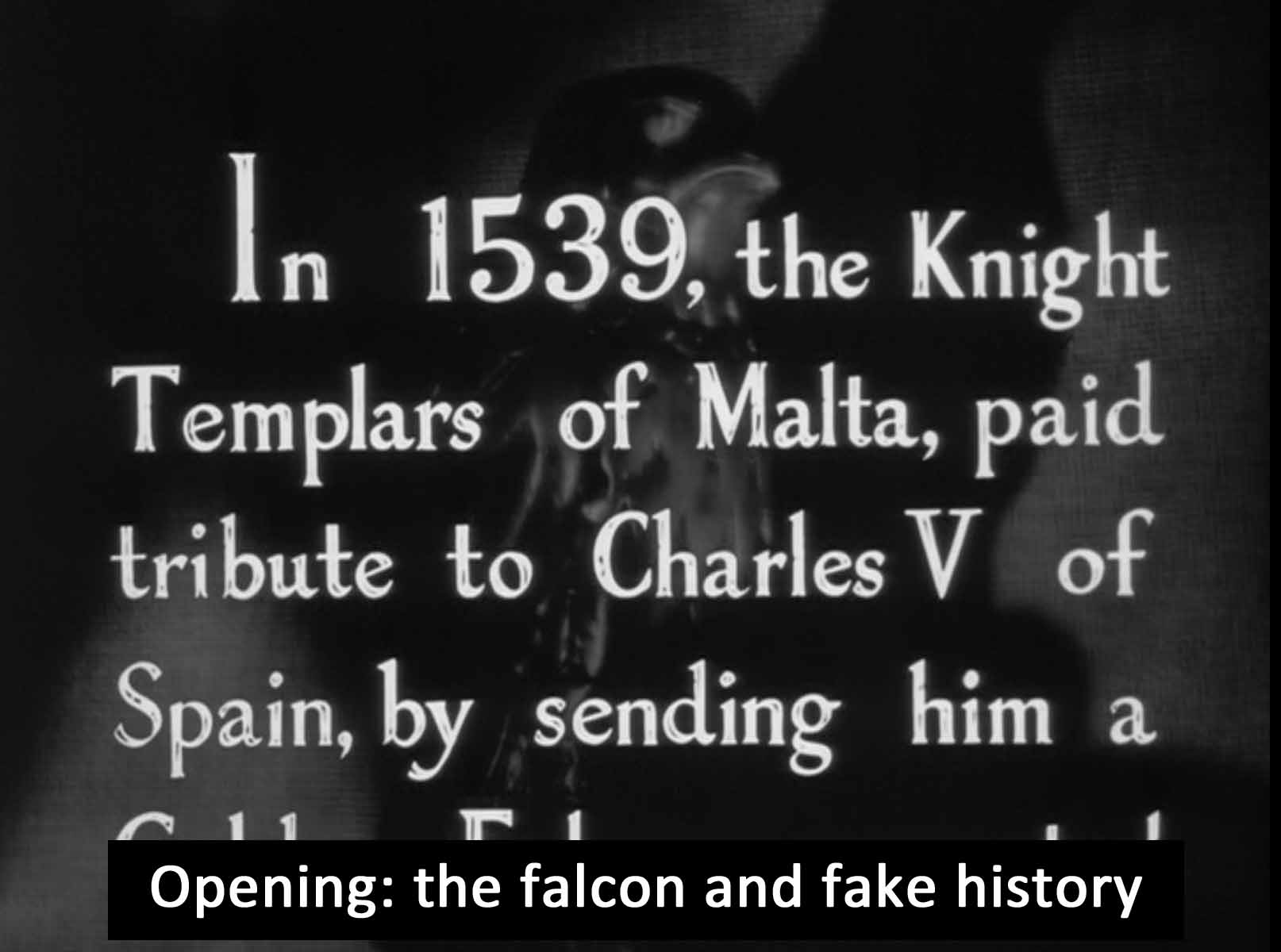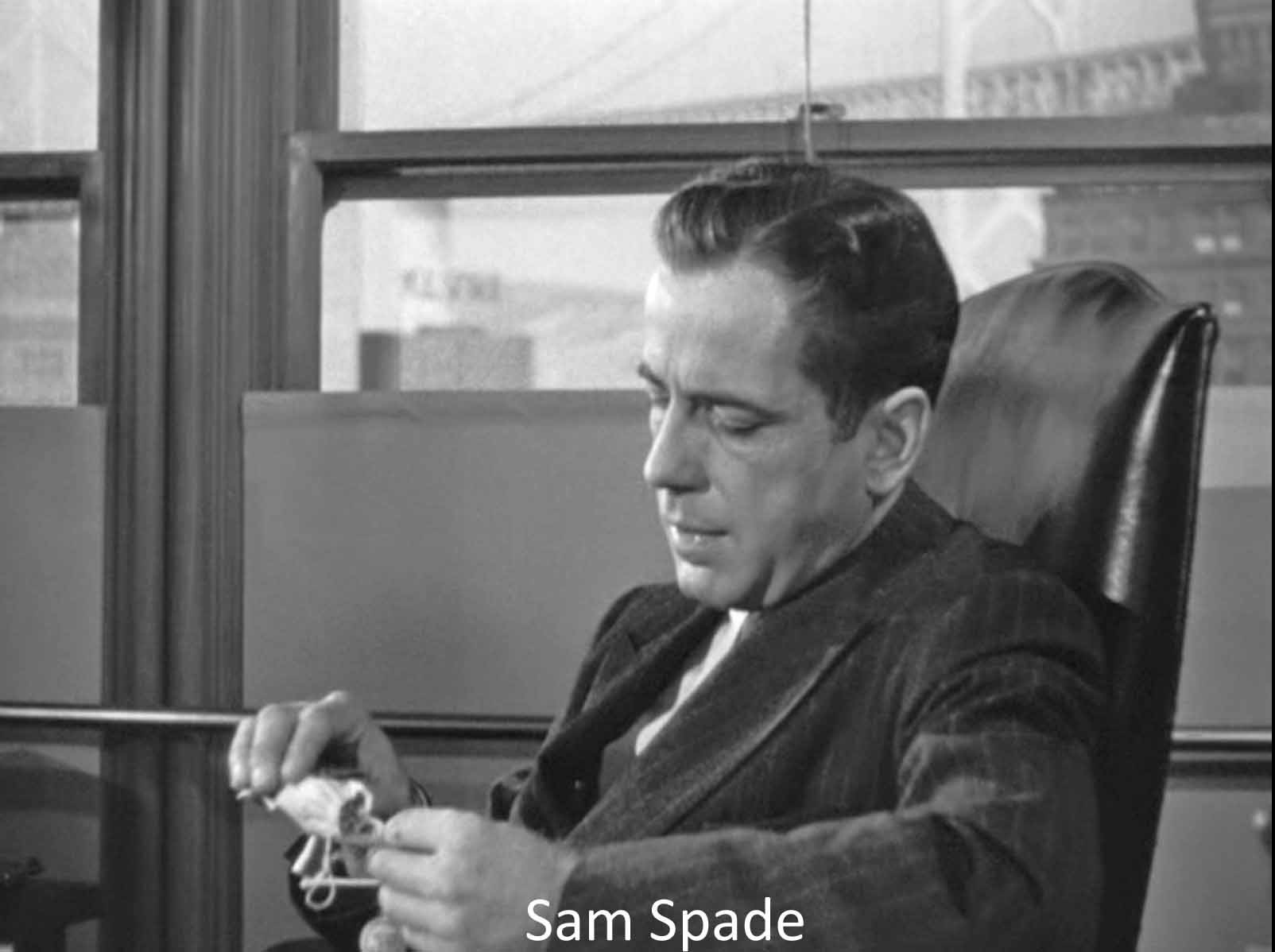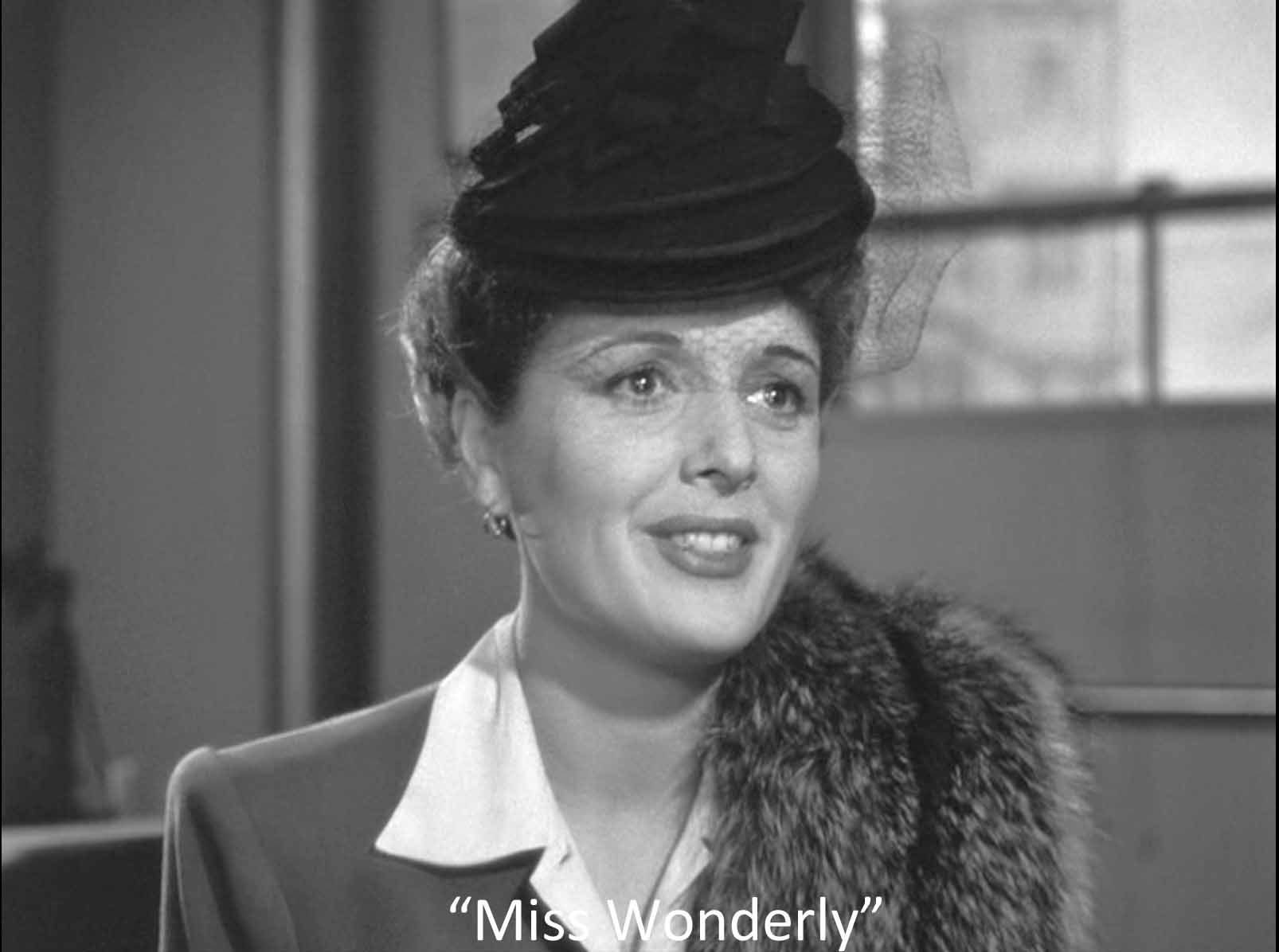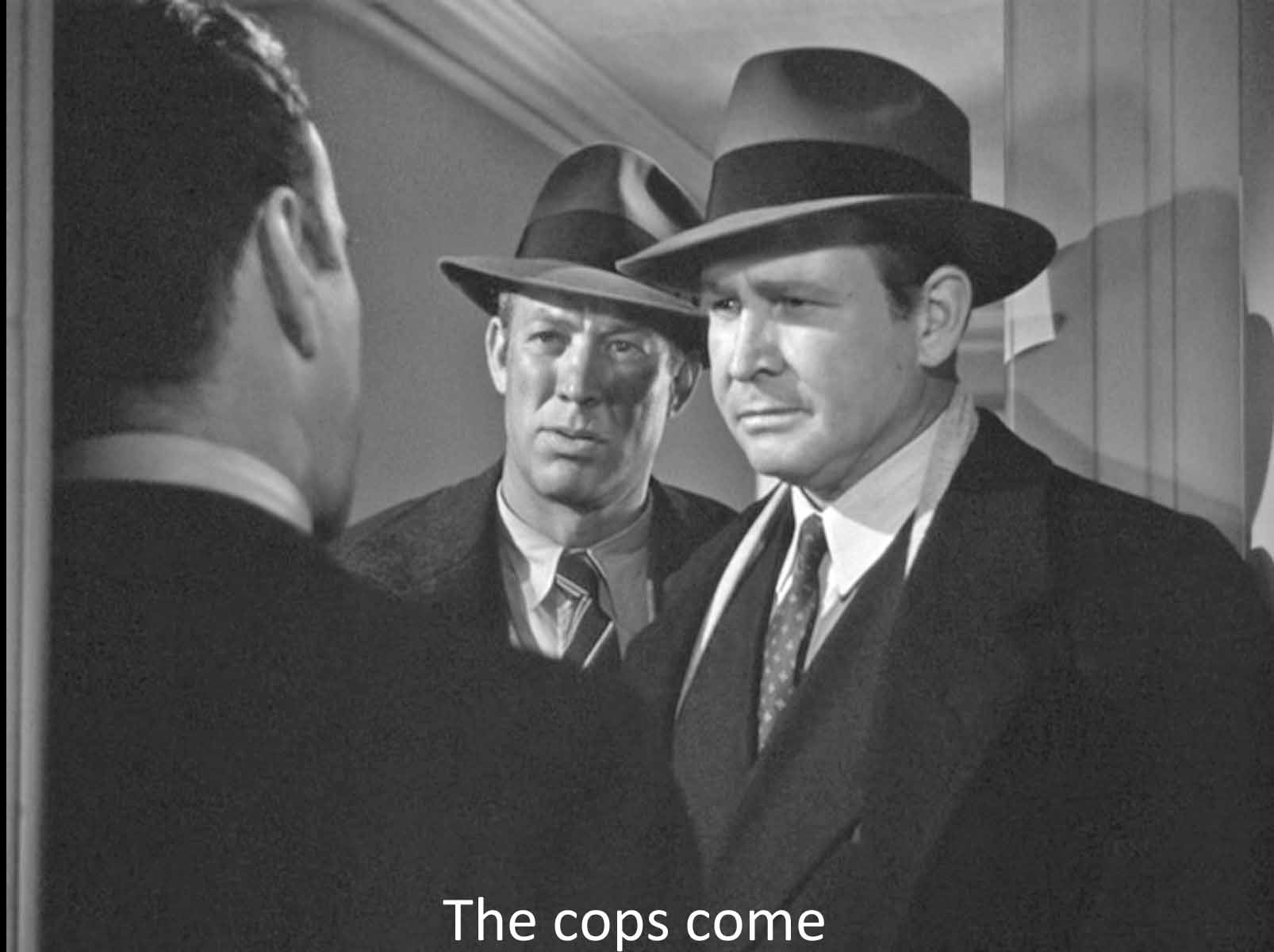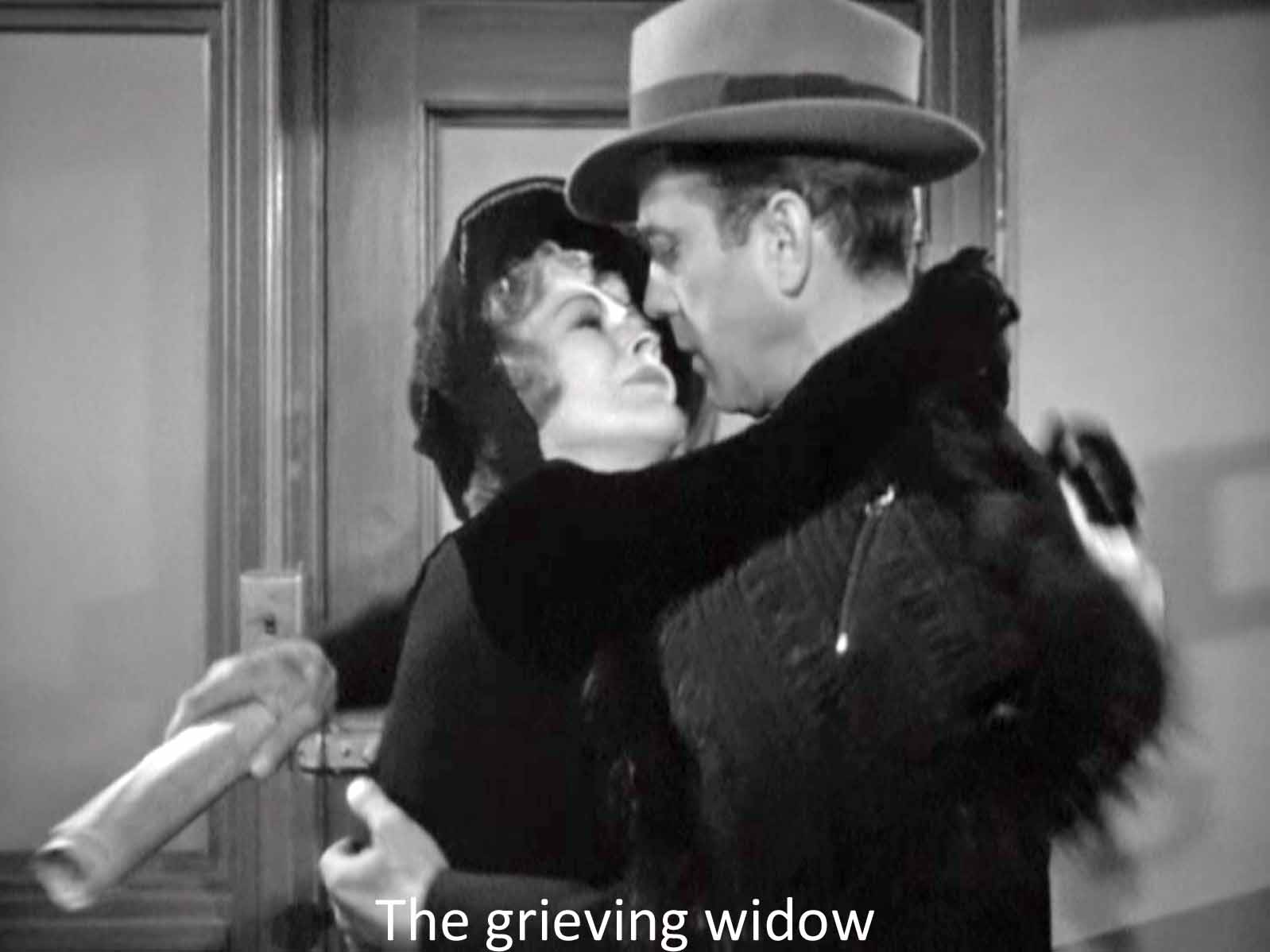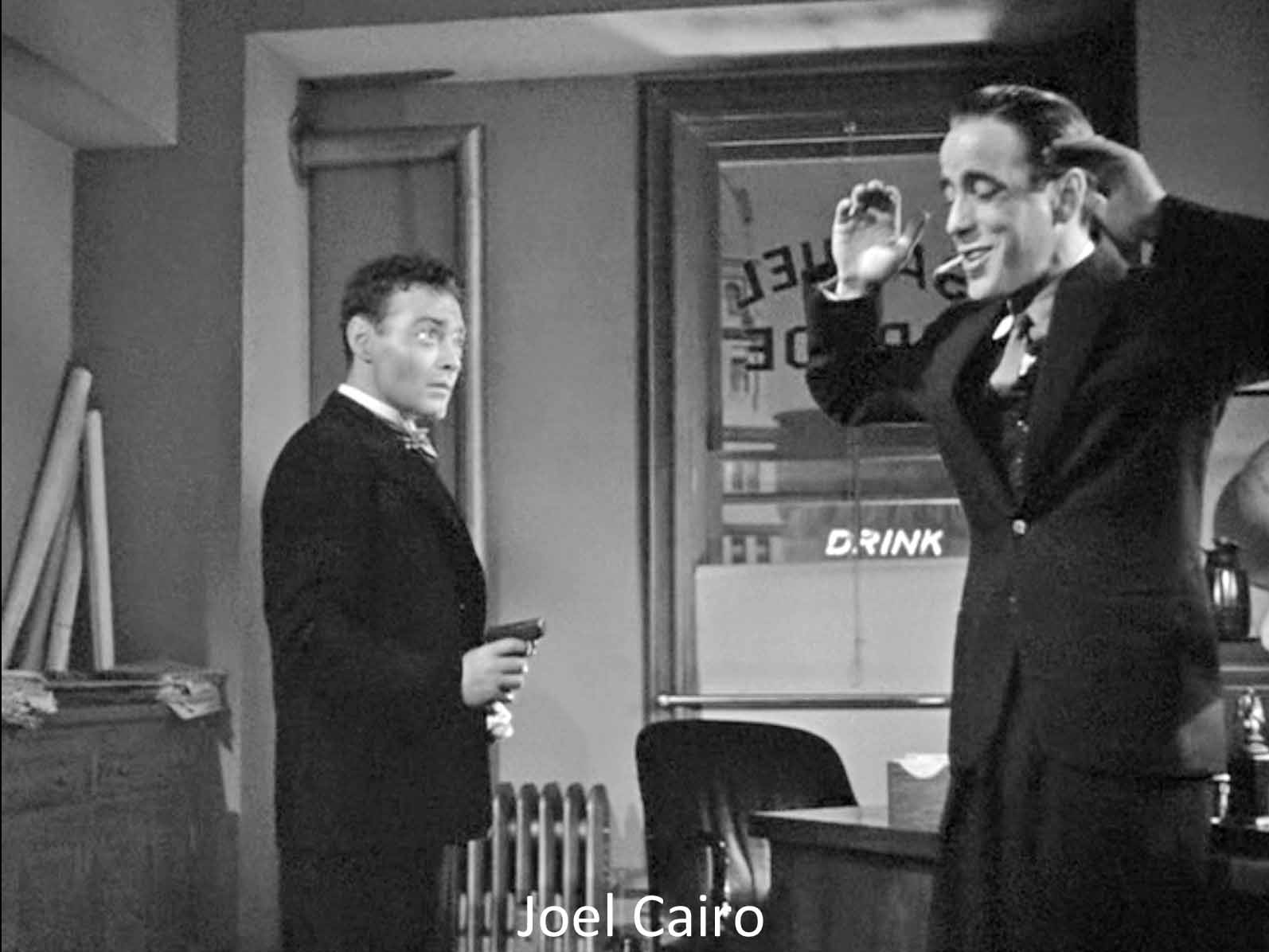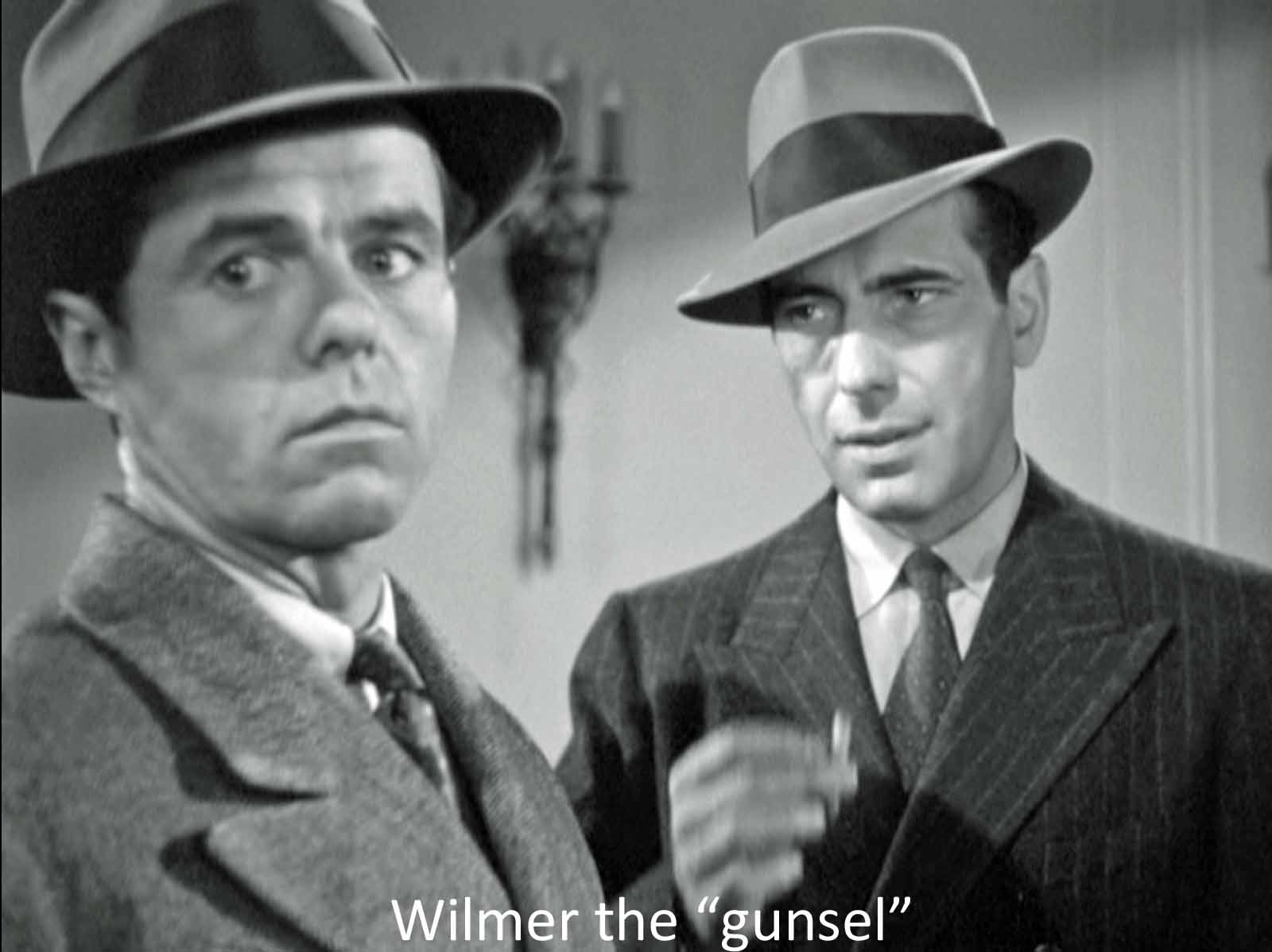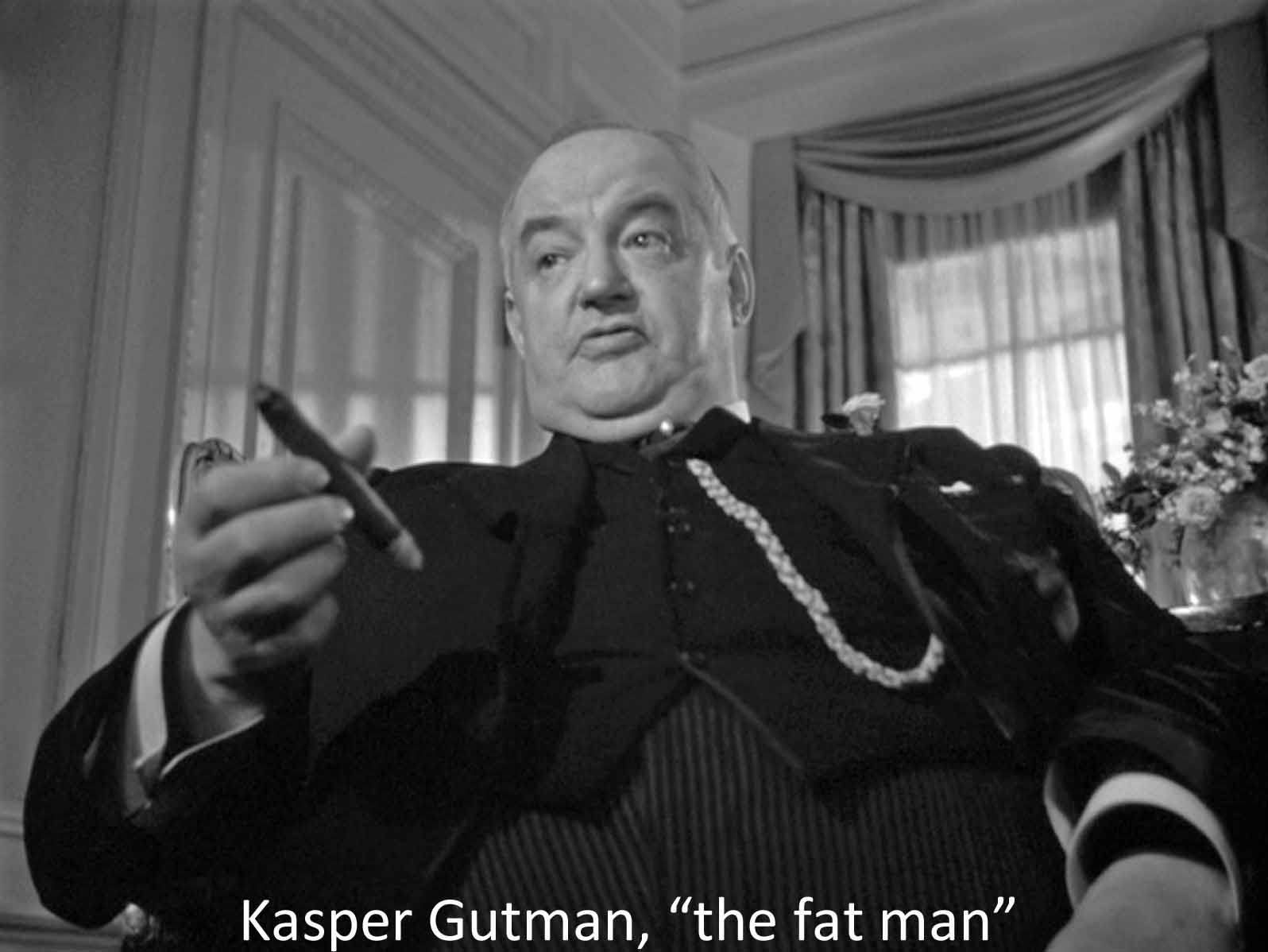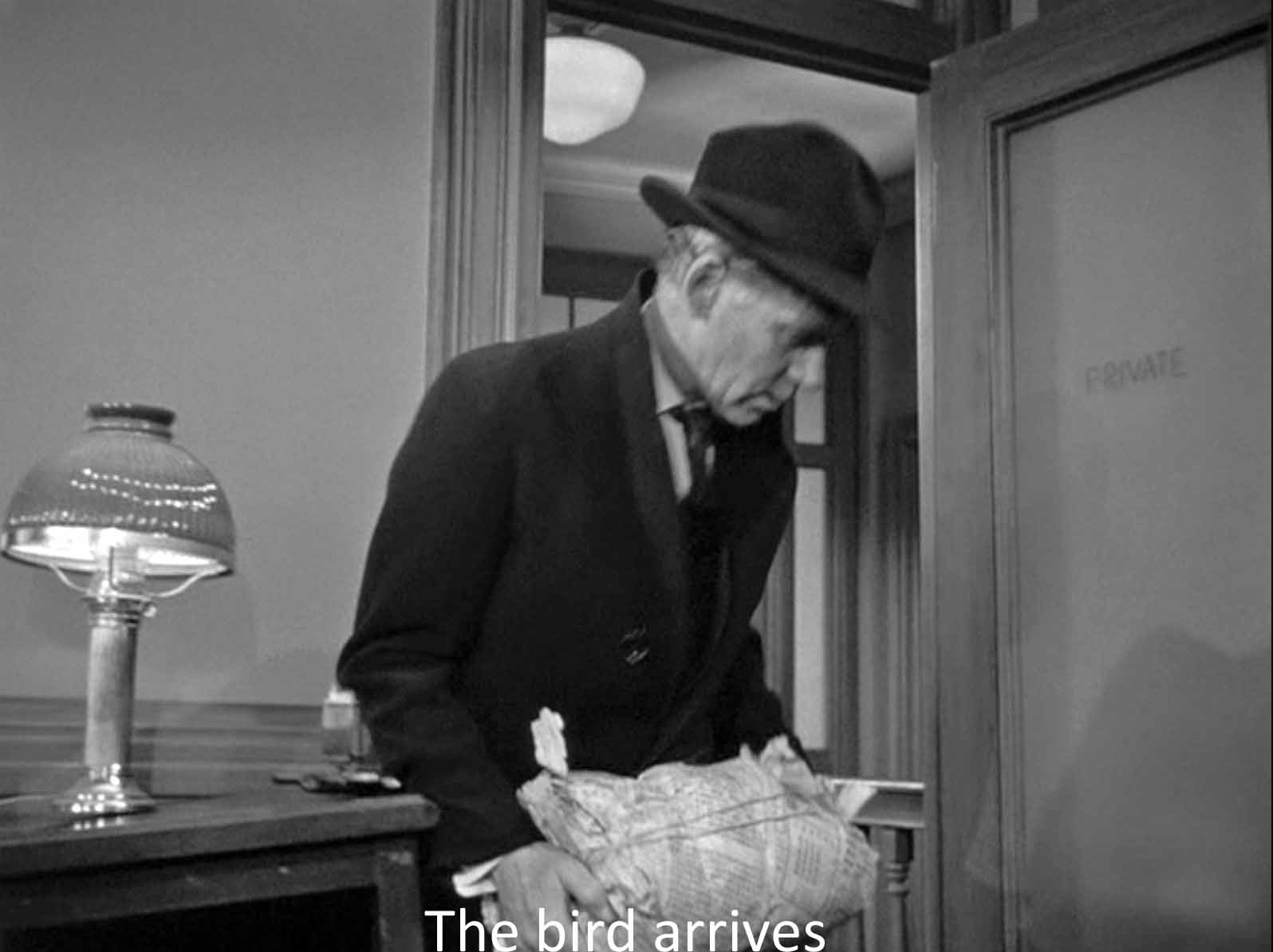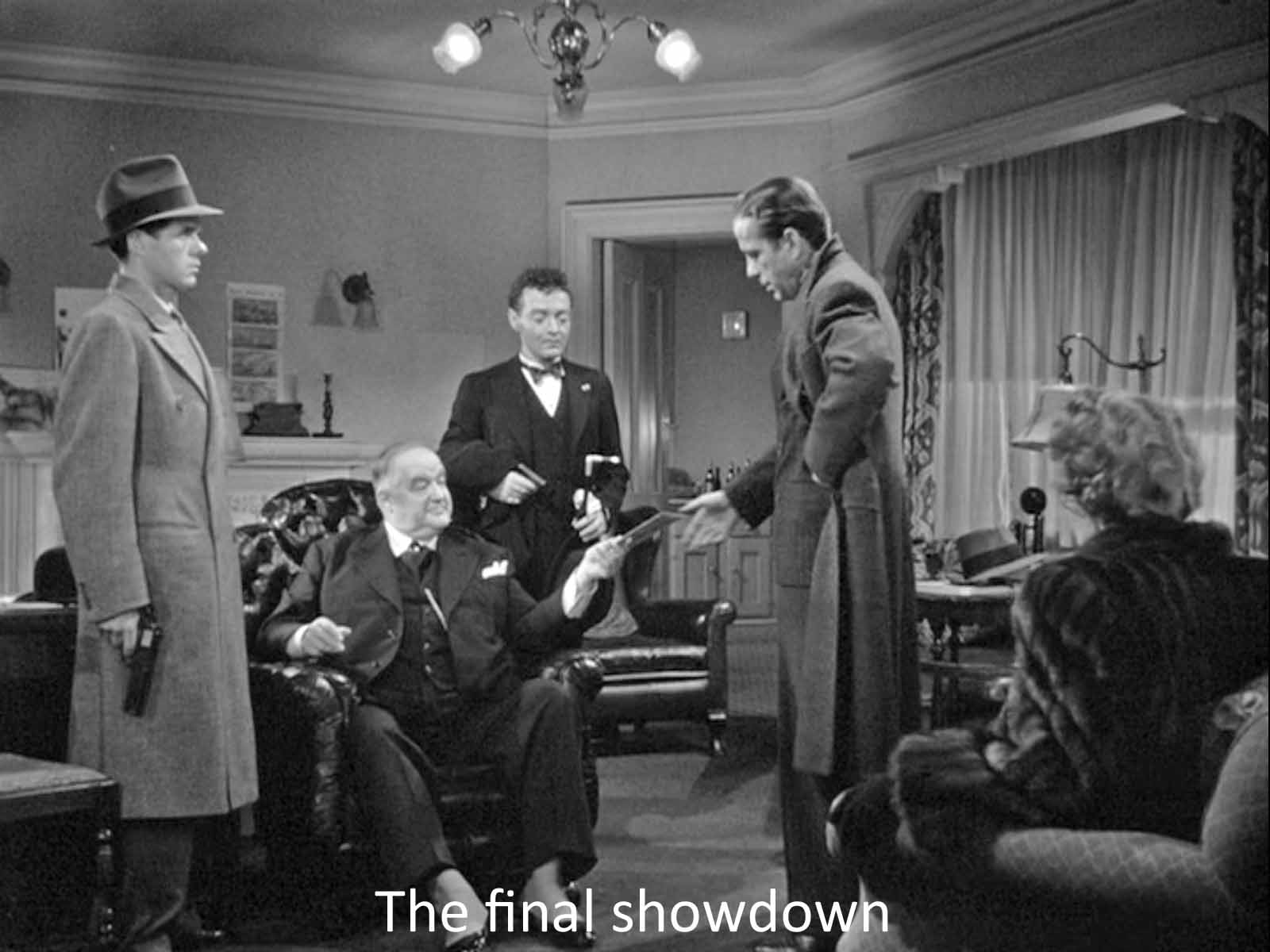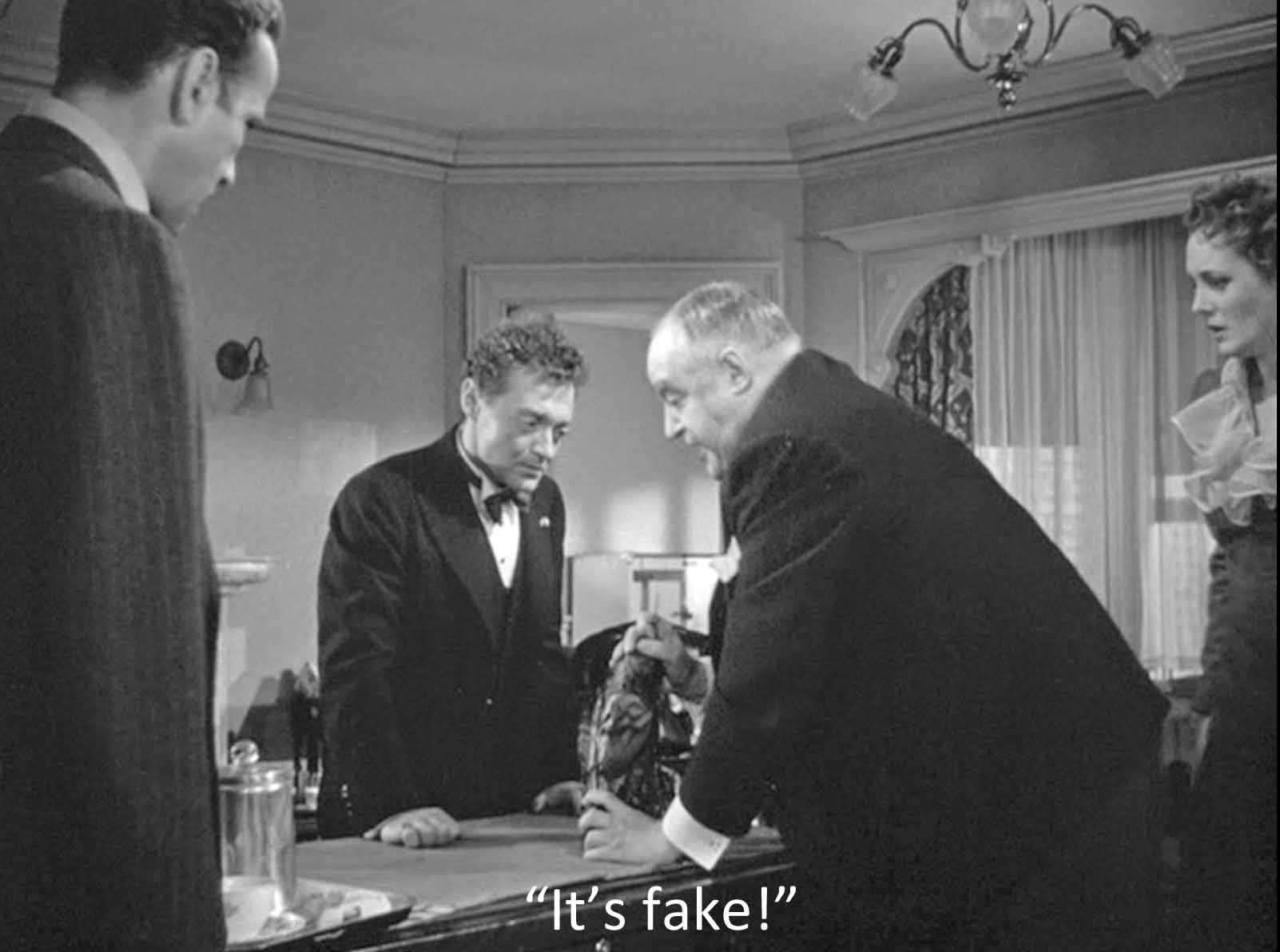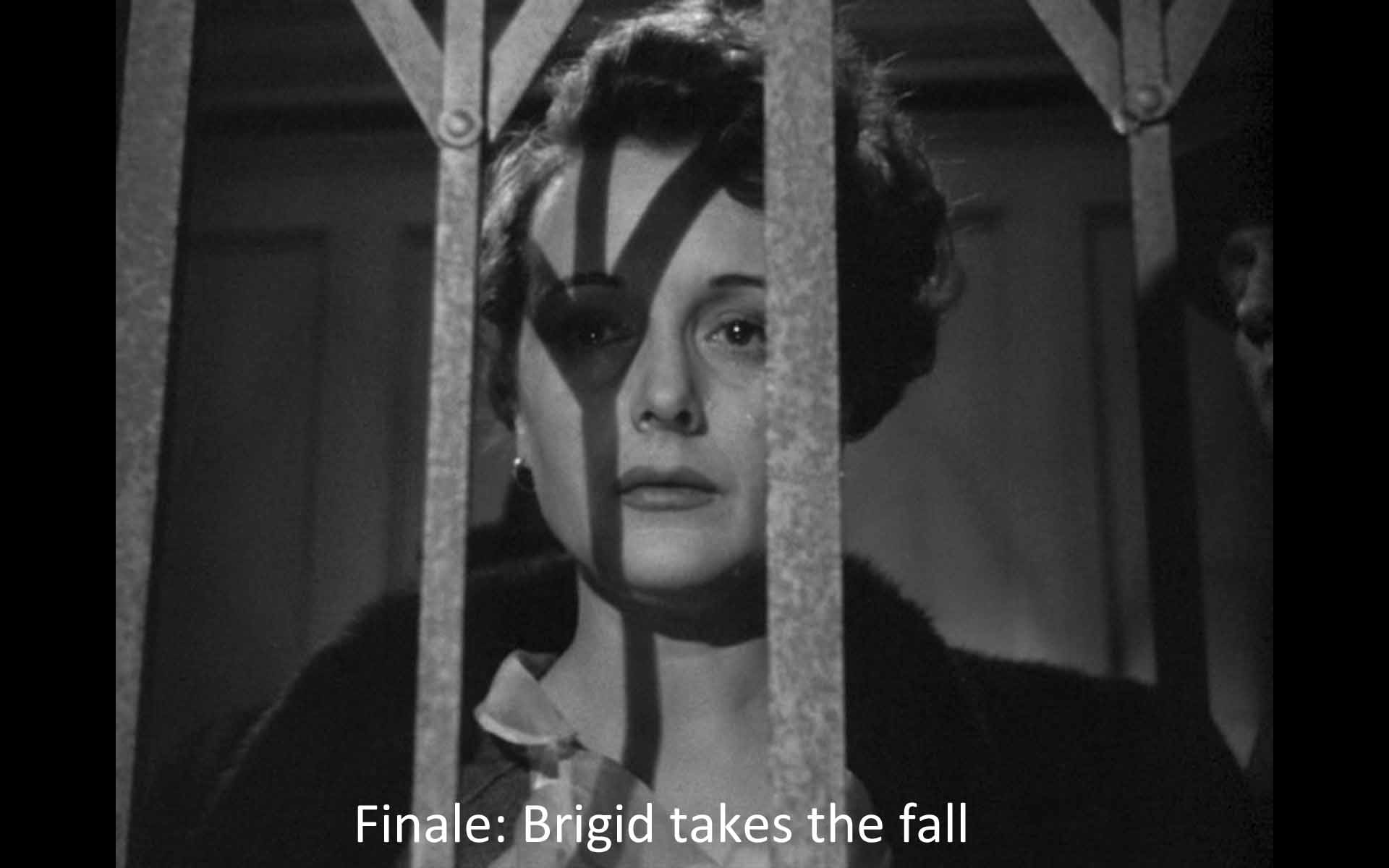It seems silly to summarize a film so well known that hundreds of people can recite its sound track from memory, but it does get a bit complicated and maybe you haven’t seen it lately—let’s make sure we’re all on the same page.
To the offices of Miles Archer (Jerome Cowan) and Samuel Spade (private detectives, what else?) comes “Miss Wonderly” (note the name; Mary Astor) who hires them (for $200, 1941 dollars) to shadow a man named Thursby. Archer (Jerome Cowan) is shot while out on the case, and Spade (Humphrey Bogart) has to fend off the untimely affections of Archer’s widow, Iva (Gladys George), with whom he had an affair and who puts the police onto him. Wonderly surfaces again, in another hotel under another alias, LeBlanc, but this time she gives her real name, Brigid O’Shaughnessy, and asks Spade to protect her against Thursby. Spade agrees (for $400 more dollars) and returns to his office where his faithful secretary Effie (Lee Patrick) leads in Joel Cairo (Peter Lorre), he of the perfumed calling card and the eloquent eyeballs. He pulls a gun on Spade and demands to search the office, but Spade disarms him. Cairo also hires Spade, this time to recover a mysterious black statuette of a bird and this time for $5,000. Spade returns the gun, and Cairo again turns on him and resolutely searches his office for the mysterious bird.
When Sam tells Brigid about Joel Cairo, she again confesses she lied and asks him to set up an interview with Cairo so she can sell the statuette to him. The interview proceeds mysteriously with much talk about the bird, that boy in Istanbul, and “the fat man.” The police interrupt, Cairo and Brigid fight, and the police take Cairo away, leaving Sam to consummate his affections for Brigid while, outside, a mysterious “boy” named Wilmer (the unforgettable Elisha Cook, Jr.) continues to shadow him—or them.
The next morning Sam establishes contact (through Wilmer) with “the fat man,” happily named “Gutman.” At their first interview Gutman (Sidney Greenstreet) refuses to tell Spade about the bird, and Sam stages a fit of temper to keep Gutman interested in him. Next he fends off the District Attorney with a similar tirade, and Wilmer leads him back for his second interview with Gutman. This time Gutman does tell him of the fabulous golden falcon fashioned by the Knights of Malta and encrusted with jewels, now hidden under a coat of black enamel. It is worth perhaps a million dollars, and these minor characters have been trying to hire Spade to retrieve it for a few thousand. Gutman offers him a quarter of a million, but this time he has drugged Spade’s drink. Wilmer viciously kicks Spade into unconsciousness, and Cairo, Gutman, and Wilmer rush out to get the falcon.
Recovering, Spade reads from a newspaper left behind that they have gone to a ship named “La Paloma,” but by the time he gets there, they all have disappeared and the ship is in flames. Back in his office, the captain of the “La Paloma” (Walter Huston, the director’s father, uncredited!) staggers in, drops a package, and dies of his gunshot wounds. The package is, inevitably, the Maltese Falcon.
Brigid telephones for help. As he goes to get her, Spade checks the treasure in the baggage office at the bus station. Brigid, however, had sent him on a wild goose chase, and, when he returns, she meets him outside his apartment and leads him into an ambush by Gutman, Cairo, and Wilmer. He has the falcon, but they have him.
All are now in Spade’s living-room, and after a hilarious set of double-crossing negotiations at Wilmer’s and Brigid’s expense, Spade agrees to turn over the falcon for $10,000 and the use of Wilmer for a “fall guy.” He calls Effie and has the bird delivered. But when Gutman frantically scratches its black surface, it turns out to be—and what else could it be but—lead. Cairo bursts into tears, Gutman twitches, and they all find that Wilmer has escaped. Gutman and Cairo decide to pick up the search again in Istanbul, and they invite Spade to join them. He declines and, as soon as they leave, puts the police on their tail. Waiting for the arrests, he has a long confrontation with Brigid in which she admits to killing his partner Miles Archer. He thereupon coldly, callously turns her over to the police and prison when they bring him the news that they have arrested the trio of bungling thieves.
Although this must be one of the most widely known, enjoyed, and loved movies in all of cinema, few have tried to make sense of it as an artistic whole—perhaps for that very reason. Enjoy! Enjoy! Who needs article?
I do. Like Freud, “Some rationalistic, or perhaps analytic, turn of mind in me rebels against being moved by a thing without knowing why I am thus affected and what it is that affects me.” For The Maltese Falcon, replace “affect” with “delight.”
Even so, the gears of the plot mesh so silkenly that images do not stand out, and while there is many a memorable line (derived from the author of the novel, Dashiell Hammett), they do not nudge me to stop and ask, “How does that fit?” For example, the opening shot: an utterly standard stock shot of the Golden Gate Bridge, a cliché for saying, “This movie takes place in San Francisco.” Or is it?
Preceding the shot of Golden Gate was a close-up of the statuette with a crawl over detailing its history. But that is a pseudo fact, made-up history, and false in other ways: the plural of Knight Templar is Knights Templars and, anyway, the tribute or an ordinary falcon came from the Knights Hospitallers. The Golden Gate bridge, by contrast, is true, factual, and Huston’s juxtaposition of the shots raises questions that run throughout the film, What is true? What is fact? What is real? Moreover, Huston presents the bridge in a curious way: first a relatively close shot, showing about a span and a half, then a dissolve to another relatively close shot of buildings on the shore, finally a shot from much farther away of the whole bridge, and cut to Spade’s office. I take it, this reverse of the conventional order (first the long establishing shot, then the close-up), indeed this use of three shots to examine something not terribly necessary, calls attention to the order in which the shots occur. First we get close-ups of Brigid, Cairo, and Gutman, and only halfway through do we get the idea of what connects them all into one coherent plot. That is, of course, Sam’s problem: to connect all these crimes and people, and that is what bridges do—connect. You also have to trust a bridge, and Sam and O’Shaughnessy discuss their lack of trust in each other at length. And her name is “Bridge-it,” although we do not know it when she appears almost immediately after the bridge. Cliché the shot may be, but I can find in it major themes of the film: truth and falsity, reversal, connecting, trust, and “Bridge-it.”
That estimable lady appears in the next shot, “She’s a knockout!,” and introduces the sexual theme. Most immediately there is reversed sexuality: homosexuality, in the person of Joel Cairo with his perfumed calling card, lacy shirts, and Turkish bath, who sits in Spade’s office mouthing his umbrella handle. Spade calls Wilmer a “gunsel.” The story goes that Huston told the Warner Brothers vice-president in charge of our morals that “gunsel” meant someone who worked with a gun, and the word has come to mean that—after this movie. But Huston was playing a trick. “Gunsel” comes from the Yiddish gantzel, gosling, and is slang for a catamite or boy toy, exactly what Gutman’s companion is. Gutman's hotel room is, like Brigid's, satiny and feminine and white, a contrast to Spade's distinctly bachelor and quite dark apartment.
In effect, the plot pits a homosexual “team” (Cairo, Gutman, Wilmer) against a heterosexual team (Spade, Brigid) aided by women (Effie, Effie’s mother) or hindered by them (Iva), but distinctly heterosexual. On that side of the balance, the women form a somewhat obscure and fragmented triple goddess. That is, they dramatize the fundamental relations of man to woman but, here, in an obscured way. Effie represents the asexual or presexual daughter or virgin, as in Spade’s classic: “You’re a good man, sister.” Iva, in black, associated with death, seems the death goddess but turns out to be simply the sexual partner, mate, or wife. Brigid at first seems the sexual partner, but she is, as Gutman says, “Very dangerous.” It is she who kills, who is the alluring death goddess.
The pattern of triple goddess is but one of many that gets reversed in this film. I’ve already mentioned the use of a middle shot or close-up before the establishing shot in the opening still of Golden Gate. The same thing happens when Sam comes to look at Miles’ body, and it happens over and over again in the film. For example, we know about Miles’ death before Spade does, and the crawl tells us at the beginning what the characters are all chasing long before Spade can figure it out. Typically we know before the characters do. Early, repeated shots of the reversed “Spade and Archer” sign on the office window also tip me to the theme. Interestingly, at the end of that scene, we see the Spade and Archer sign projected through the window onto the floor, now not reversed, as if the projection of the movie will reverse all these reversals.
Still more intensely, incident after incident breaks the pattern of what I have got accustomed to or would normally expect. Iva comes to the office ostensibly to mourn Miles but immediately embraces Sam. Cairo pulls a gun on Spade to search his office, then hires him, then (when he gets his gun back) pulls the gun again. Gentlemanly Gutman gives Spade a drink—the second time, it is drugged. Brigid repeatedly lies and playacts. “I’m tired of lies,” she says, but does it again and again. Sam is, she says and so does Gutman, “wild and unpredictable,” “astonishing.” He likes to playact sudden outbursts. He stages a tantrum for Gutman, then shows us later outside it was playacting. Then he stages a tantrum for the D.A., but breaks off and coolly addresses the stenographer showing that he is pretending anger at the very moment he is pretending anger—truly an unpredictable actor, an actor acting a man acting—neat trick.
In general, the whole style of the film involves sudden reversals of convention or plot: things in the “wrong” order or expectations reversed. And this, I think, is one of the great charms of the picture: it fools me—or, if I am one of the cognoscenti, it fools the others but not me. No wonder it is a cult film.
By fooling even its own audience, the film asks, Whom can you trust? There are long dialogues between Sam and Brigid about trust, but they and everybody else accuse everybody else of lying—and they’re right. Even Spade lies (or bluffs, at least). Only Effie is straight throughout (even to the police at an awkward moment!). Her name is short for Euphemia, “of good report” (although it could also echo “efficient” or “ephemeral”). You can trust the person without desire. In the final showdown, all their faces show greed, and they have been cheerfully willing to send pathetic Wilmer to his doom.
What is a fact? What is true? The film begins and builds on the pseudo-factual idea of a “Maltese Falcon,” false gold, desired by everyone, to be contrasted to the true Golden Gate Bridge to which we are (in the film, at any rate) indifferent. The film drives to unravel surface falsity only to come to more falsity until finally we close in on the unwrapping of the bird and scraping through its surface: ultimate falsity. As soon as the opening bridge shot cuts to Spade’s office we get lies: “Miss Wonderly.” Miles immediately checks her bills to see if they are counterfeit. If Archer be the soldier of the two detectives, the gunslinger (Latin miles=soldier), Spade is surely the digger into truth and falsity. The solid thing—the black bird, the law—is false. The ephemeral talk of the various crooks is false. Only Spade’s unpredictable moral stance becomes the final truth.
Throughout, Spade and the film strive to connect things, enlisting us (or me) in the process. I was struck by the many telephone calls, and I realized I was trying hard to make sense of the incomprehensible voice on the other end, inferring from the voice I could hear and trust (Spade’s, always). I had to “make the connection.” Similarly, I was impressed by the number of signs: street signs, theater marquees, or room numbers, means to connection, a way you can find something and involves yourself with it, yet the one time Bogart tracks down a street number, it turns out to be a vacant lot.
Cigarette lighters, of which there are a number in this film, work by connecting elements. The film has its share of fire and smoke, too, the various lightings of cigarettes, enlarged into the fire in Brigid’s hotel room, culminating in the firing of the “La Paloma.” That boat’s name fits another pattern: birds. First the “gunsel” or gosling, then the “La Paloma” or dove, culminating in the Maltese Falcon.
A sign of Sam’s independence is his rolling his own cigarettes—the others smoke ready-mades. Similarly, he decorates his apartment with pictures of horses he presumably does not own, that lose his money for him. A recurring image in shots of his apartment is the window with a curtain blowing in it, the window as connecting inside and outside, the curtain as something that hovers between being “in it” and “out of it.”
There are a great many shots of windows and doors and doorways in this film. I think they form a major element in Huston’s filmic style. Key elements of the story appear in corners or at edges of the frame: Wilmer making his escape at the end, Cairo getting off an elevator with the newspaper announcing the “La Paloma” under his arm, Miles’ body at the edge of the frame. The frame connects things, brings them all together, the way Spade gets all the thieves in one room at the end. Then, desire frustrated, they scatter again. Or, to put it another way, because of their wishes to hold and to possess, people draw themselves and others and objects together into a frame. But at the end, Spade walks down the stairs and out of the frame.
Desire leads to trust, but the person who desires cannot be trusted. You can trust Spade to the extent he overrules his desires. You can trust, really, only Effie. Desire fuels deception, certainly of other people, but also of self, in the crooks’ overestimation of their own cleverness and their resulting belief that they are chasing the genuine article.
Is my desire that deceives me? I want this film to come together, and I read its outcome as its moral stance. Desire traps the others, locking them into prison. Only Spade goes free, and precisely because he overrules his desire. He finally tells Brigid he won’t cover for her: “I won’t because all of me wants to . . . . You’ve counted on that with me the same as you counted on that with the others.” Brigid, like the Maltese Falcon itself, is the figure of men’s desires, but you can’t hold onto her. Even the law will have to let her go—after twenty years. At the end, Spade ends up with the worthless bird, but he, the man who transcends desire is free. Not greed, not homosexuality, not heterosexuality, not even lust for law, traps him.
The final moral value seems to be: stay free. Do not be trapped either by your own desires or laws or the laws and desires of others. Desires will catch you in the frame of prison or death.
This moral reading one could derive simply from Dashiell Hammett’s novel, but it seems to me the film uses the paradox of trust and desire aesthetically and filmically as well as morally and literarily. Huston’s desires fuel the film as much as the fat man’s or Cairo’s. He brings them all together into his frame and into the sequence of events, building to greater and greater complexity. He uses my desires as well. When the film reverses conventions or expectations, Huston is playing against my wishes, teaching me the paradox that holds the film together. Desire leads to a trust which, being based on desire, cannot be trusted. The picture fools me. What a stunning debut for director Huston, well deserving its three nominations for Oscars, Best Picture, Best Supporting Actor (Greenstreet), and Best Adapted Screenplay (Huston himself). As so often with Oscars, I think it deserved wins rather than nominations. How Green Was My Valley? Give me a break!
